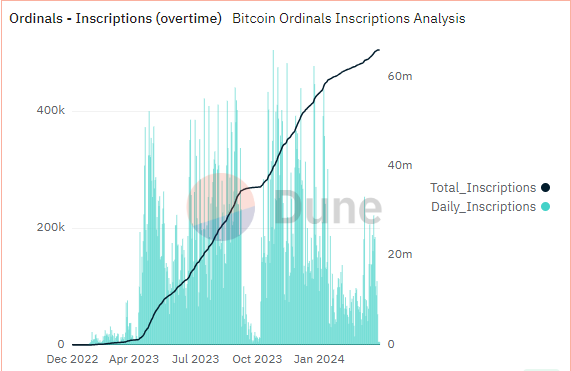By facilitating decentralized peer-to-peer transactions, Bitcoin offers an alternative to traditional payments. Yet while transferring and storing value remain its primary functions, crypto inscriptions have introduced broader applications for the Bitcoin network.
Inscriptions allow users to store data directly on the blockchain, such as images, audio, videos, and more. Even though this started with Ordinals on Bitcoin, inscriptions have spread to other networks, attracting a mixture of curiosity and concern among community members. This guide covers crypto inscriptions, their history, how they work, and the benefits and drawbacks they bring to decentralized ecosystems.
Methodology
BeinCrypto tested the top exchanges to purchase inscriptions over a period of six months. The criteria for the top platforms included fees, reputation, safety, products and services, and features. OKC, Gate.io, and Binance reflect the qualities seen in the top inscriptions platforms. Here’s why we chose each platform.
Gate.io
Gate.io is a global exchange that has low fees, a vast array of products and services, and wide availability for customers in various countries. Alongside inscriptions, customers can also stake, mine, trade derivatives, and a multitude of other activities.
- Inscription and Runes market
- Inscription launchpad
- Batch inscribing
- Inscription explorer
Binance
As the world’s largest exchange by trading volume, Binance customers can enjoy low fees and tight spreads. In addition to its inscriptions services, customers can also trade spot, NFTs, futures, optons, on margin, and with trading bots.
- BTC Transaction Accelerator
- Integration with UniSat
- Bitcoin and EVM inscriptions
OKX
OKX is an expansive exchange that allows users to not only trade crypto at low fees, but also use earn products, trade derivatives and spot, use trading bots, and trade on margin. Users can also trade peer-to-peer or or trade NFTs.
- Trade inscriptions from 20+ chains
- Manage Runes, Ordinals, Ethscriptions and moe
- Use live market data
To learn more about BeInCrypto’s Verification Methodology, navigate to the following webpage.
- Where to buy crypto inscriptions?
- Gate.io
- OKX
- Binance
- What are crypto inscriptions?
- Bitcoin Ordinals: The early days of crypto inscriptions
- How do crypto inscriptions work on Bitcoin?
- Benefits and drawbacks of crypto inscriptions
- Crypto inscriptions: Novelty or serious innovation?
- Frequently asked questions
Where to buy crypto inscriptions?
Gate.io
Gate.io is an expansive cryptocurrency exchange that serves a global suite of users. On the platform customers can enjoy low trading fees, a wide variety of cryptocurrencies (including inscriptions and Runes), NFT trading, futures trading, and more.
OKX
OKX boasts a large marketplace for inscriptions. Users can inscribe, exchange, and manage inscriptions, doginals, ordinals, and atomicals for free. Along with its wide range of products, OKX is well-known for its earn products, derivatives, and NFTs.
Binance
Binance is the world’s largest exchange by trading volume. It has some of the lowest fees, a wide selection of crypto to choose from including inscriptions, and an assortment of products and services. Users can even take advantage of its proprietary BNB blockchain for developing or using decentralized applications (DApps).
What are crypto inscriptions?
In the case of Bitcoin, inscriptions are metadata added to individual satoshis (sats), the smallest unit of BTC. Inscriptions arise from people inscribing sats with arbitrary content, creating Bitcoin-native digital artifacts.
The rise of Ordinal inscriptions on Bitcoin occurred when Casey Rodarmor, a Bitcoin developer, created the Ordinals protocol, which launched in January 2023. The Ordinals protocol — made possible by the Taproot and SegWit upgrades — uses Ordinal Theory to number, identify, and track sats, allowing Bitcoin to support the creation and trading of tokens.
When sats are inscribed, they can be transferred through Bitcoin transactions, directed to Bitcoin addresses, and stored within unspent transaction outputs (UTXOs). However, you’ll need an address that can receive Ordinals, as standard BTC addresses won’t work here.
Bitcoin Ordinals: The early days of crypto inscriptions
While Bitcoin Ordinals became popular in January 2023, the concept of non-interchangeable tokens on Bitcoin was not new. In the traditional Bitcoin framework, all Bitcoins were treated as equal. However, in 2012, so-called colored coins emerged as a method to represent and manage real-world assets on the Bitcoin blockchain. This allowed Bitcoin’s utility to expand beyond being a peer-to-peer currency. However, the additional “non-financial” data increased demand for block space, which strained Bitcoin nodes.
Colored coins used “metadata injection” to add metadata. However, the method was inefficient and had capacity limitations. To address this, the Bitcoin community introduced the OP_RETURN function in 2014 as part of the Bitcoin Core 0.9.0 release. This function enabled users to “store” arbitrary data on a Bitcoin transaction output, preserving it within the Bitcoin block space.
The impact of Segwit
In 2017, the segregated witness (SegWit) update was activated on Bitcoin. Before SegWit, the OP_RETURN function stored arbitrary data within the transaction block, along with existing details such as the sender or receiver’s address, the transaction time, etc., on Bitcoin.
SegWit separated signature information from transaction data, helping to optimize block space and making transactions cheaper.
Sponsored SponsoredThe impact of Taproot
In 2021, the Taproot upgrade expanded upon SegWit’s foundation by introducing Schnorr signatures, which were more efficient, secure, and smaller, contributing to the overall reduction in transaction size. These advancements enable transactions to accommodate larger metadata payloads, resulting in faster processing times and reduced transaction costs.
Introduced in January 2023 by Casey Rodarmor, Ordinal Theory was built upon its preceding developments. This made the creation of Bitcoin-native assets simpler.
What is Ordinal Theory?
Ordinal Theory describes the systematic ordering of satoshis and the inscription of data onto them using the Ordinal protocol. Ordinals are satoshi’s numerical system, allowing tracking and data transfer. These designations, referred to as Ordinal numbers, are assigned to satoshis based on the sequential order in which they are mined.
Users could now trade Bitcoin NFTs directly on the blockchain. With the creation of Ordinals, users can now inscribe content such as videos, images, text, PDFs, and audio onto individual satoshis.
Taproot Wizards
Shortly after introducing Ordinal Theory, Taproot Wizards, an Ordinal project, was launched in February 2023, featuring a collection of 2121 collectible digital wizards cards. Subsequently, Ordinals garnered considerable attention from established projects, leading notable entities like OnChainMonkey, DeGods, and Yuga Labs, the creators of the Bored Ape Yacht Club (BAYC) NFT collection, to join the Bitcoin network. These inscriptions can be viewed and traded on various NFT marketplaces.
The concept then spread to Ethereum and other Ethereum Virtual Machine (EVM)-compatible chains such as BNB Chain, Polygon, and Avalanche, where users, enticed by low transaction costs, started embedding data within transactions. Notably, Ethereum is the most popular blockchain for non-fungible tokens, featuring some of the top NFT card collections, such as CryptoPunks and BAYC.
Data from Dune Analytics shows a notable surge in inscription volume on the Bitcoin blockchain.

As inscriptions gained traction over time, the community expressed concerns about issues such as high transaction fees and the long-term effects on the scalability of the Bitcoin network. A Bitcoin developer, Luke Dashjr, called inscriptions a “bug” that needs to be fixed, saying that they were bringing vulnerabilities to the blockchain by embedding data on top of it.
While critics have been vocal about the issues with inscriptions, in late 2023, Rodarmor criticized Bitcoin maximalists over their complaints and attempts to “censor” inscriptions.
“Simultaneously believing that Bitcoin is unstoppable internet money and thinking that a bunch of [redacted] publishing JPEGs on-chain is any kind of problem is a contradiction.”
Casey Rodarmor: Rodarmor.com
After inscriptions hit the market, building upon the Ordinals protocol, developer Domo introduced the BRC-20 token standard, enabling the issuance of fungible tokens on the Bitcoin network.
ORDI became the first BRC-20 token launched on Bitcoin. Following its launch, the idea gained market adoption, leading to BRC-20 marketplaces allowing the buying and selling of tokens.
How do crypto inscriptions work on Bitcoin?
Crypto inscriptions allow users to embed data into satoshis. They are created by packaging arbitrary data, like an image or document, stored in Bitcoin’s “witness data.” This inscription data is limited to 520 bytes, while creating larger inscriptions requires linking them.
The inscribed satoshi is transmitted to the network through two sequential transactions: a commit transaction and a reveal transaction. The commit transaction creates a Taproot output committing to the script with an inscription. Subsequently, the reveal transaction discloses the entire script, enabling the creation of the inscribed satoshi output.
Upon transmission, these transactions enter the mempool, awaiting confirmation by miners. Once mined, the inscription becomes a permanent fixture on the Bitcoin blockchain. Users then employ tools such as the Ordinals Explorer to facilitate tracing and viewing of inscriptions.
Unlike normal Bitcoin transactions or Ethereum NFTs, creating, minting, and tracking inscriptions necessitates running the proprietary “ord” client on top of a fully synchronized full node.
Sponsored SponsoredThe “ord” client, in conjunction with Bitcoin Core, enables users to inscribe individual satoshis and track them across the UTXO set. Without this client, a regular Bitcoin wallet cannot distinguish between inscribed and regular satoshis.
Did you know? Casey Rodarmor created the first Ordinal inscription on the Bitcoin blockchain, inscription #0, on Dec. 14, 2022. The inscription was a pixel art representation of a black-and-white skull.
Benefits and drawbacks of crypto inscriptions
Below are some of the benefits and drawbacks of crypto inscriptions as observed on the Bitcoin network, its pioneer use case.
Benefits
- Immutability: Data inscribed on the Bitcoin blockchain inherits its strengths — unparalleled security and immutability. After being inscribed, the data cannot be altered or deleted.
- Flexibility: Inscriptions support different data types, allowing users to store a wide variety of data, such as digital artwork, personal details, important files, and images.
- Decentralization: Inscriptions leverage Bitcoin’s decentralized nature. No central authority controls the data, promoting transparency and resistance to censorship.
- Enhanced Bitcoin functionality: Bitcoin’s original purpose primarily centered around facilitating peer-to-peer (P2P) transactions. However, the emergence of Bitcoin inscriptions has expanded its utility.
- Increased miner revenue: Including inscriptions in transactions boosts cryptocurrency transaction fees, providing additional income for miners and enhancing Bitcoin’s security budget.
- Accelerated second-layer adoption: Inscriptions use has prompted increased adoption of second-layer solutions, improving network efficiency.
Drawbacks
- Fungibility concerns: Assigning non-fungible attributes to satoshis may challenge Bitcoin’s fungibility.
- Blockchain bloating: A larger block size demands more resources for storage and processing, potentially affecting transaction verification speeds and placing additional strain on the network’s nodes.
- Pruning possibility: Inscription data can be pruned from Bitcoin nodes. This potentially compromises the integrity of Ordinary transactions.
Crypto inscriptions: Novelty or serious innovation?
Crypto inscriptions are a significant advancement in digital assets. They allow the embedding and transfer of digital artifacts directly within the blockchain, creating new asset creation and transaction opportunities.
While there are challenges, such as concerns about fungibility and blockchain scalability, crypto inscriptions have brought about more security, efficiency, functionality, and adoption.




